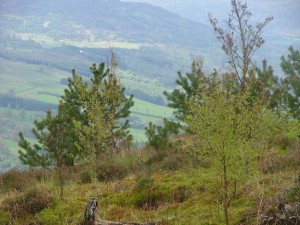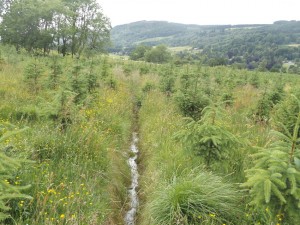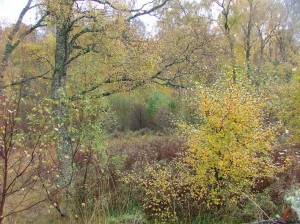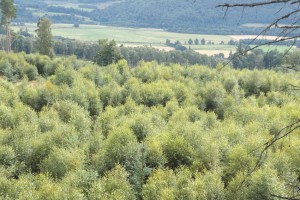Woodland management and creation are two of the areas of public interest that SNH will be paying particular attention to in the DMG review process in 2019, but the mechanisms to deliver these outputs do not always work smoothly. The Scottish Government has made forestry and woodland expansion a priority with ambitious growth targets and ha asllocated funding accordingly but many farms and estates have had or are having difficulties in gaining approval for suitable projects.
This short article by Victor Clements looks at both woodland creation and management of existing woodlands and discusses some of the issues and context surrounding the outputs to which deer management groups are expected to contribute.
Woodland creation
There are many good reasons for creating new woodland areas in Scotland, and, historically, estates within deer management groups have made a significant contribution to this. Diversifying upland habitats and providing deer shelter for the future are strong motivations. Highland farms and estates are often in a position to create larger schemes than might otherwise be possible elsewhere, and indeed, in the last round of the Scottish Rural Development Programme (SRDP), what we might define as the ‘deer management group area’, a little under the half the total land area of Scotland, contributed the majority of new woodland creation, and a higher still proportion of new native woodlands.
The table below shows planting activity within the DMG areas in the last round of SRDP 2008 – 2014.
| RDC Option | Ha in DMGs | Ha outwith DMGs | Total Ha | % in DMGs | % of DMG planting |
| Productive conifer – low cost | 2,650 | 3,832 | 6,482 | 41 | 11 |
| Productive conifer – high cost | 458 | 313 | 770 | 59 | 2 |
| Productive broadleaf woodland | 153 | 283 | 436 | 35 | 1 |
| Native woodland planting | 19,000 | 9,330 | 28,330 | 67 | 78 |
| Native woodland – natural regen | 1,015 | 320 | 1,335 | 76 | 4 |
| Mixed conifer/ broadleaved | 783 | 1,444 | 2,227 | 35 | 3 |
| N & W Isles Native woodland | 3 | 30 | 33 | 10 | 0 |
| Central Scotland mixed woodland | 343 | 1,464 | 1,807 | 19 | 1 |
| Total | 24,405 | 17,016 | 41,422 | 59 | 100 |
So 59 per cent of all woodland creation took place in the DMG areas, which included two thirds of all native woodland planting and 76 per cent of all native woodland regeneration.

Throughout this period, 2008 – 2014, the Scottish Government had a planting target of 10,000ha per year, although this was never achieved, averaging about 7,000ha per year. In simple terms, the level of planting achieved was mainly driven by grant support available, although initial difficulties with the SRDP scheme effectively prevented any new schemes from coming forward in 2008, and the system then took another year or so to get going. Regeneration schemes were high risk in the way that the SRDP was structured, so the area established was modest indeed.
Native woodland plantings and the Highland area in general did well out of the first round of SRDP but, not surprisingly, the timber industry’s interest was primarily in planting Sitka spruce rather than in native woodland so as to secure future material for sawmills. The figures above show this.
To encourage the planting of more conifers, the planting rate was decreased by £400 per ha for native woodland and increased by £400 per ha for conifers. The initial effect of this in 2016 was that significant native woodland plantings more or less stopped, while conifer planting also remained low, at least for another year or so, before they started to increase.
| Year to 31 March | Total (1000ha) |
| Conifers | Broadleaves | Total | |
| 2008 | 0.7 | 3.4 | 4.2 |
| 2009 | 1.2 | 2.3 | 3.4 |
| 2010 | 0.5 | 2.2 | 2.7 |
| 2011 | 1.8 | 4.2 | 6.0 |
| 2012 | 3.3 | 5.7 | 9.0 |
| 2013 | 1.7 | 5.3 | 7.0 |
| 2014 | 2.0 | 6.3 | 8.3 |
| 2015 | 2.5 | 5.1 | 7.6 |
| 2016 | 1.9 | 2.7 | 4.6 |
| 2017 | 3.2 | 1.5 | 4.8 |
| 2018 | 4.7 | 2.5 | 7.1 |
Source: Forestry Commission Grant Schemes
In 2016, the extra £400 per ha was reinstated for native woodland plantings, and a higher fencing grant made available for woodlands in more remote areas. This should have opened the doors for more Highland native schemes, but the figures are not yet showing this to be the case. Some DMG member estates have reported surprising obstacles being placed in the way of what they believe to be good schemes, and it would be helpful to know how widespread this is. One example is a requirement that new schemes should be connected to existing woodland with applications being turned down unless this is the case.

If there are genuine obstacles to planting schemes on suitable sites in the Highlands, it is important that they be removed. The current grant rates should be sufficient to encourage schemes to come forward but there is some confusion as to how the rules are being applied. In the short term, all of this creates a potential problem for the DMGs in the context of the 2019 Scottish Government review of deer management as the upland deer sector could be construed as falling short in terms of the important public interest objective of native woodland expansion.
Obviously, the Scottish Government cannot support high rates of both conifer and broadleaved planting at the same time with a limited budget, but clarity is required as to which is to take precedence. The enthusiasm from landholders for native schemes is certainly there subject to there being positive signals from Government based on targeted incentives and clear rules. Hopefully the new pre-application consultation approach will improve the speed at which worthwhile schemes can be developed and processed and save cost and time for applicants.
Better local information on schemes
A number of DMGs have highlighted the problem of woodland schemes being established within or near to their boundaries without their knowledge or them being consulted. While a DMG should expect its own members to consult them on new schemes, it can often be the case that forestry investors can buy and plant land within or adjacent to a DMG area without reference to neighbours, often with significant local consequences.
Recently, East Sutherland DMG has successfully persuaded the Highland Conservancy of Forestry Commission Scotland to notify them of any schemes coming forward in their area so that they can make comment if applicable. This is a big step forward, and we need to move quickly to a situation where all DMGs are notified either by the applicant or FCS as a matter of routine of any woodland schemes in their area. Involving deer management interests in forestry and woodland planning is in the interests of all concerned. Otherwise the danger is of inadequately designed schemes that increase deer/traffic accidents and risks to deer welfare.
Regeneration of existing woodlands
Regeneration schemes in the first round of SRDP were high risk, and very few people entered into them. The new SRDP seemed to have resolved this, covering fencing costs and having a more realistic and flexible approach to outputs. However, the requirement for more woodland creation has effectively taken funds from the management and regeneration of existing woodlands, to the point where regeneration schemes outwith designated sites may not be considered. Even within designated sites, the prescriptions are being applied in such a way that schemes can be impracticable, and there is no way of recouping the cost of rejected applications. More flexibility as to local circumstances rather than a uniform application of scheme rules is necessary.

The result is that although there is supposedly a focus on regenerating native woodlands and a willingness among land managers to participate, the mechanism remains flawed, so inhibiting efforts to bring designated sites back into favourable condition as well as efforts to reach 2020 Biodiversity targets more widely. One woodland owner has recently remarked that if the Scottish Government cannot support efforts to improve designated sites by woodland regeneration when there is a willing participant, then they should be de-designated. It is difficult to disagree.
As with woodland creation, we have to ask the question again: “Do the people of Scotland want more trees or not?”
The Native Woodland Survey of Scotland (NWSS)
This is a big issue for DMGs in relation to the 2019 Review and discussions are ongoing between ADMG and SNH about this. All native woodlands have had herbivore impacts measured on a scale of Low – Very high, and land managers can find information on their properties here
Land owners/managers should zero in on their property, and then click on the Native Woodland Survey of Scotland folder on the right-hand side, and then the NWSS herbivore impact tab. Higher impacts are red and orange, lower impacts are green. The level of low and medium impacts within most DMG areas is actually very good although that is often not the perception.

In many woods, the impacts stated do not make sense on the ground, both as to level and cause, and we have many examples of this, with impacts being overstated or understated significantly. Have a look at your own woods. If you think your stated impacts are wrong, please get in touch with ADMG. The NWSS information can be up to 11 years old now and, if it is to be used to dictate significant changes to deer or sheep populations throughout the country, then we need to have confidence that it reflects present reality.
The time to look at all of these things is now, when we have a space to gather information, and collate and present it. If you have native woodlands on your property and have concerns about their classification or are having difficulty in sourcing SRDP funding to implement good management or woodland creation, please get in touch with ADMG.
Victor Clements is a woodland advisor working in Aberfeldy, and a member of the Executive Committee of ADMG

